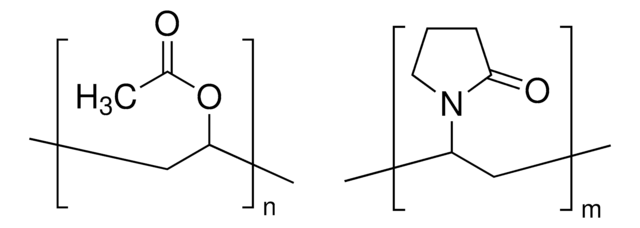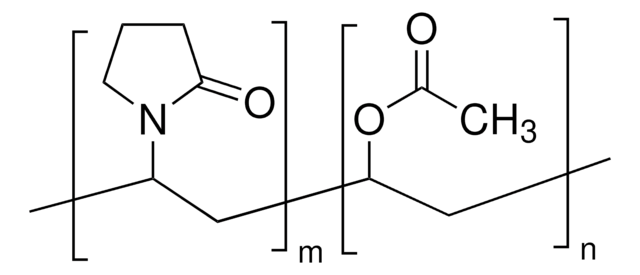02286
Polyvinylpyrrolidone
Synonyme(s) :
PVP, Polyvidone, Povidone
About This Item
Produits recommandés
Niveau de qualité
Impuretés
≤1 ppm hydrazine
≤10 ppm heavy metals (verified on random samples only)
≤10 ppm lead (verified on random samples only)
≤10 ppm vinylpyrrolidinone
≤3.0% 2-pyrrolidone
≤400 ppm peroxides (as H2O2)
≤5.0% water
≤500 ppm aldehydes (as acetaldehyde)
≤5000 ppm formic acid
12.0-12.8% nitrogen (anhydrous basis)
Résidus de calcination
≤0.1% (verified on random samples only)
pH
3.0-5.0
Adéquation
complies for Infrared spectrum
Application(s)
sample preservation
Chaîne SMILES
C=CN1CCCC1=O
InChI
1S/C6H9NO/c1-2-7-5-3-4-6(7)8/h2H,1,3-5H2
Clé InChI
WHNWPMSKXPGLAX-UHFFFAOYSA-N
Vous recherchez des produits similaires ? Visite Guide de comparaison des produits
Application
Kollidon SR is a blend of polyvinyl acetate and povidone (K 30) in the ratio 8:2 for use as matrix-forming agent. This research grade product is intended for use in R&D and development only.
Autres remarques
Informations légales
Code de la classe de stockage
11 - Combustible Solids
Classe de danger pour l'eau (WGK)
WGK 1
Point d'éclair (°F)
Not applicable
Point d'éclair (°C)
Not applicable
Certificats d'analyse (COA)
Recherchez un Certificats d'analyse (COA) en saisissant le numéro de lot du produit. Les numéros de lot figurent sur l'étiquette du produit après les mots "Lot" ou "Batch".
Déjà en possession de ce produit ?
Retrouvez la documentation relative aux produits que vous avez récemment achetés dans la Bibliothèque de documents.
Les clients ont également consulté
Notre équipe de scientifiques dispose d'une expérience dans tous les secteurs de la recherche, notamment en sciences de la vie, science des matériaux, synthèse chimique, chromatographie, analyse et dans de nombreux autres domaines..
Contacter notre Service technique


